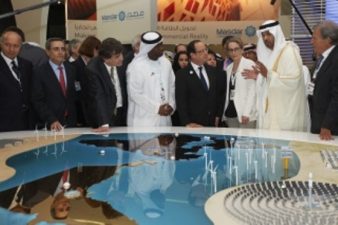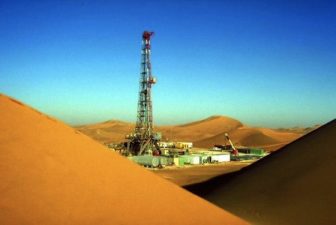
Solar panels station in Morocco. Ericsson has been supplying networks with solar power since 2000. The first was in Morocco, but since then there are more than 200 solar sites around the world.
Speaking as a weather-girl, the Sahara gets twice as much sunshine annually as most of Europe, even the winter months pack a dry heat no European country has faced. Speaking in PR terms for energy-saving, the European Union wants to get 20 percent of its electricity from renewable sources within a decade. Free Sahara sunshine in one continent and the EU’s desire for renewable sources in another continent…? There is a formula in this somewhere.
The Electric Idea: How about building several solar power plants across North Africa and shipping the electricity up north via power lines under the Mediterranean sea? This is exactly what the Desertec Industrial Initiative (DII) are doing.
During the past year, more than 30 European ‘blue chips’ (financially sound companies) have joined the DII, which is a consortium (association of several companies) that seeks a monumental $560 billion investment in North African solar and wind installations, for over the next 40 years.
In this light, the DII is currently completing a feasibility study and hopes to be building its first power plant by the year 2013. A separate group of companies called Transgreen, formed in July 2010, is also working on plans for the thousands of miles of high-voltage power lines that are needed to run under the Mediterranean sea. The challenge is immense: They must win an agreement from very different countries on two continents to carry out one of the biggest infrastructure projects in history, ever.
The weather isn’t consistent either.
Fortunately many groups have backed the solar power project, for a sumptuous share of the rich construction contracts. They include Germany’s Siemens and the Swiss-Swedish group ABB, solar companies Abengoa Solar from Spain and the company First Solar from Arizona.
These companies have their own goals too; the Italian utility Enel for example wants to rely less on Russian gas, and Munich Re, Germany, sees this project as a bold force against damage from global warming. “We are creating a large network of allies with complementary interests,” said Paul van Son, boss of Desertec Industrial Initiative.
Concentrating Solar Power (CPS) allows a “field of mirrors” to extract concentrated heat from sun rays to drive turbines, which continuously produce electricity.
There’s little doubt that the Sahara sun can power most of Europe. Existing cables already carry electricity under the Mediterranean, and after years of false starts, hundreds of large-scale solar power plants are now being built or are in advanced planning stages.
However, concerns arise surrounding the overall cost of production. With the technology the consortium plans to use, solar-powered electricity costs at least four times as much per kilowatt-hour compared to power from coal-fired and gas-fired plants, according to Bloomberg New Energy Finance, an analysis group.
The depth of political support in North Africa is another issue. While Morocco, Tunisia, and Egypt back the project, Algeria wants to develop solar plants on its own. And some European critics, meanwhile see this solar power project as over-ambitious. Hermann Scheer, a member of the German Bundestag who heads Eurosolar said “European countries can develop a faster and cheaper (than Desertec) renewable energy supply from indigenous sources”.
On the other hand, even Europe’s sunniest regions don’t get enough sunlight to generate power as efficiently as in North Africa, says Abengoa Solar CEO, Santiago Seage. The Sahara’s abundant space is also crucial to the project because the plans call for ‘fields of mirrors’, which will total hundreds of square miles, at more than 20 different locations. These mirrors would concentrate the sun’s rays to create heat and drive turbines. This is a technology known as concentrating solar power (CSP). It allows heat to be extracted and stored gradually so electricity is being generated continuously.
As the consortium develops forward, some European countries could split and strike deals with North African suppliers. Morocco, for example, has already announced plans to build solar plants for its own use. Since Morocco’s government can’t afford the subsidies that would make solar power feasible in its country, it might team up with Spain or France to help with financing in exchange for a share of the output, as suggested by Logan Goldie-Scot, a London-based analyst with Bloomberg New Energy Finance.
“The [Desertec] project will happen,” he says, yet “it’s likely to be a series of small projects.”
Images :: tfgsummit :: BrightSource Energy




What is the feasibility of the project? Since, this is the high time for investing and discovering alternative sources of energy and solar energy is one of the best possible sources available. If this really works out and economically feasible, this will be best gift to the future.